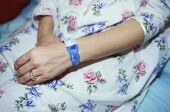
MONDAY, Dec. 20 (HealthDay News) — Lung cancer patients who develop a rash after treatment with the drug cetuximab (Erbitux) have better outcomes, according to a new study.
German researchers compared hundreds of patients with non-small cell lung cancer who received chemotherapy plus cetuximab and hundreds of patients who received chemotherapy alone. About 70 percent of the patients who received the combination therapy developed an acne-like rash within the first three weeks of treatment.
Compared to other patients, those who developed the rash lived longer (15 months vs. 8.8 months), had better progression-free survival (5.4 months vs. 4.3 months) and had a higher response rate (44.8 percent vs. 32 percent), according to the report by Dr. Ulrich Gatzemeier, from Hospital Grosshansdorf in Germany, and colleagues.
The findings, published online Dec. 19 in The Lancet Oncology, suggest that the early appearance of a skin rash may help identify patients who would be most likely to respond to treatment with cetuximab and gain the greatest survival benefit, the researchers noted.
The study authors concluded that further clinical trials are needed “to verify this finding and assess it fully in the context of possible clinical application.”
In a commentary accompanying the report, Dr. Francesco Perrone from the Istituto Nazionale Tumori in Naples, Italy, added: “The only way to verify the hypothesis that skin rash predicts the benefit of cetuximab is a randomized trial that compares interruption versus continuation of cetuximab in patients with skin rash after three weeks of treatment with cetuximab and chemotherapy.”
The findings, Perrone continued, “must be validated prospectively before we consider the introduction of cetuximab into clinical practice for the treatment of patients with advanced non-small cell lung cancer.”
More information
The American Cancer Society has more about non-small cell lung cancer.

